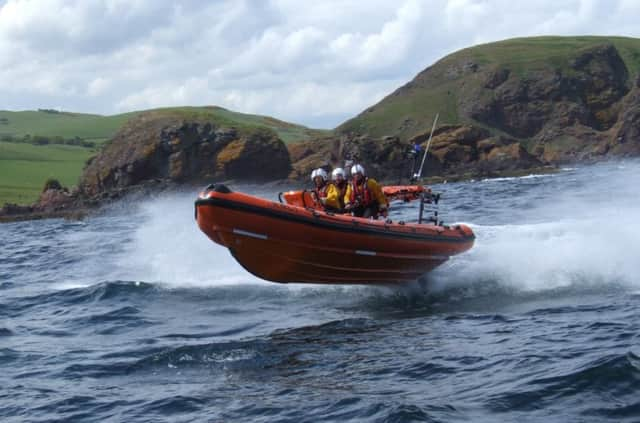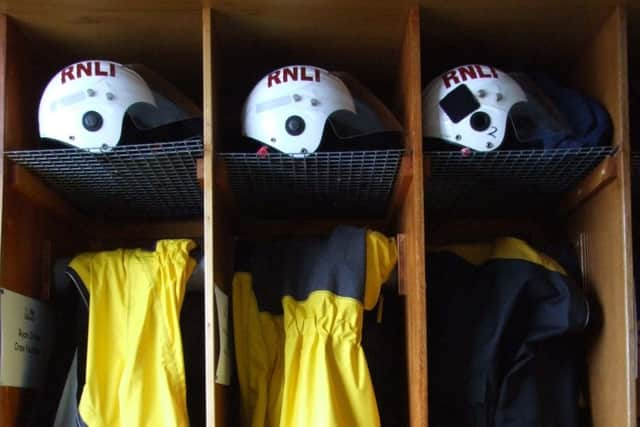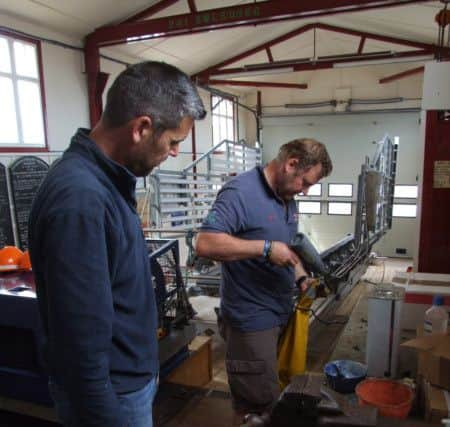Swan song for St Abbs lifeboat station


MARION McFarlane owes her life to strangers.
On 30 May, the experienced scuba diver and three “buddies” were on a shore dive at Cathedral Rock, just a few metres from the harbour of St Abbs in the Borders, when the accident happened.
“I was about 13 metres down. I tried to breathe, and suddenly there was no air from my regulator. I tried my octopus (reserve) and that wasn’t working either,” she says on the phone from Fife, a few days after being discharged from hospital.


Advertisement
Hide AdAdvertisement
Hide AdIt is every diver’s nightmare. Underwater, your air supply is your life, and it’s not until it stops that you realise how deep 13 metres really is.
“I had no choice but to fin up,” she says. “I hit the surface and tried to breathe in, but I must have got water in my lungs already. Then I passed out.”
In another place, and at another time, she would have drowned. But the divers were being watched – and the watchers knew just what to do.
“I was looking out from my house, and I saw her buddies pulling her on to the rock. That was enough for me,” says Euan Gibson, a resident of St Abbs. “I phoned Paul, the lifeboat cox, and his wife said he was already on the way. Then I went out in my car to get the rest of the crew.”


Paul Crowe runs the Rock House diving centre, right on the harbour’s edge, and he, too, had been watching. By the time Euan roared into the harbour with two lifeboatmen in his car, Paul was already running for the boat.
“I got the boat out and the guys jumped in. When we got to her, her buddies were heaving her out of the water, so we put her straight onto oxygen,” he says. “We got her into the ambulance, and she was airlifted away to Aberdeen.”
In the stress of the moment, nobody is quite sure of the details. Paul says Marion was alert enough to hold the oxygen mask herself; Marion has no memory of it.
“I didn’t wake up until I was in the helicopter and they were cutting my drysuit off,” she says.
Advertisement
Hide AdAdvertisement
Hide Ad“And after that, I spent six hours in the decompression chamber.”
Still, she was lucky: she is alive, and she knows why.
“My buddies were convinced I was a goner until the RNLI arrived,” she says.
For her, it is a story of discipline triumphing over danger. Her own training, her buddies’ support and the lifeboat’s quick response made the difference between life and death.
But the St Abbs lifeboat team is in danger, too. The same month they rescued Marion, they were told that the RNLI plans to shut down their lifeboat station.
After 104 years of fighting for other people’s survival, they are now fighting for their own.
The lifeboat men’s job is to save lives at sea. The job of the RNLI is to manage 236 lifeboat stations scattered along 19,000 miles of coastline. Neither job is simple.
“The RNLI has a duty to our supporters through the objectives of the charity to use our assets and supplies in the best way we possibly can,” explains George Rawlinson, the RNLI’s operations director.
“If we didn’t close stations for which there wasn’t a requirement, we would have many more stations than we have already. That would put a burden on our revenue, our capital support, our maintenance and our people,” he says.
Advertisement
Hide AdAdvertisement
Hide AdSt Abbs currently houses an Atlantic 75-class lifeboat, a rigid-hulled, twin-engined inflatable that can carry three crew.
A few miles down the coast, the lifeboat station in Eyemouth has a much larger boat, a Trent class capable of operating 100 miles out to sea. The RNLI has decided to add a second boat to Eyemouth, a D-class inflatable, and retire the St Abbs boat.
“Looking at what we can provide from Eyemouth with the combination of an all-weather boat and an inshore boat, we believe all the indicators are that the service in that area can be provided by one station in Eyemouth.
“It isn’t about a requirement to save money, but it does enable us to do other things,” the operations director says.
And for St Abbs and its crew, that is that.
The lifeboat station towers over St Abbs harbour. Inside, the sunlight glints off rows of helmets, overalls and yellow RNLI wellies. The hangar-like boathouse is full of scents: salt water, seaweed, engine oil, glue.
At a workbench, Paul and crewman Ian Wightman are repairing a drysuit. A row of wall plaques records the rescues the St Abbs crew have carried out – 226 lives since their foundation in 1911, according to official figures.
A picture shows Miss Jane Hay, who campaigned for the lifeboat’s establishment after the Danish cargo ship Alfred Erlandsen was wrecked close by with the death of all 17 crewmen. Local legend records that only a dog, a great dane, survived.
Looking at pictures of lifeboats past, the St Abbs operations manager, Alistair Crowe, sighs.
Advertisement
Hide AdAdvertisement
Hide Ad“My father served 56 years on the lifeboat. I’ve done 50 years. I’ve got five brothers who were in, they all did 30-odd years. That’s some record, and now they’re going to lose all that experience,” he says.
These Crowes are seabirds. Paul is Alistair’s son. A cousin, Darren, won a medal when he swam into a breaking sea to rescue a fisherman from a cave. The rescue was so dramatic that the RNLI filmed a reconstruction and posted it on their website, rnli.org.
Like all RNLI crews, they are volunteers. Paul runs a dive boat. Alistair and Darren are fishermen. Members of their family have been manning the lifeboat since there was a lifeboat to man.
When it comes to the lifeboat, St Abbs is very much a family.
“Everyone mucks in with the lifeboat, fundraising or helping out. Now we’ve all lost it,” says Kelly-Ann Barnett, who works in the harbour café. “It’s devastated the community.”
“St Abbs has been synonymous with the lifeboat and the lifeboat has been synonymous with St Abbs for over 100 years. It’s like taking the heart out of the community,” agrees Euan.
It is a rare thing for the RNLI to close a lifeboat station. Only three have been shut down in the past decade or so, and they did not go without a fight.
“We don’t take the decision to withdraw a boat lightly. Local communities have objected strongly in the past, but in a balanced analysis, it’s the right thing for the organisation to do,” says George.
Advertisement
Hide AdAdvertisement
Hide AdHe underlines that it is not the end for the lifesavers of St Abbs. The RNLI focuses on accident prevention as well as rescue, teaching divers, kayakers, sailors and surfers how to avoid accidents.
As St Abbs is one of the most popular diving sites in Scotland, there is a real call for that sort of work.
“We want to work with the diving community to understand why accidents happen and what we can do to prevent them. So I feel that there’s an important role for the St Abbs community in coastal safety,” George says.
The community, however, is up in arms. A petition to save the lifeboat, hosted at www.change.org, has gathered more than 3,500 signatures.
It has the backing of MSP Paul Wheelhouse, and a number of RNLI governors – significant private donors. They have penned a joint letter to the RNLI’s chief executive, saying simply, “Keep St Abbs lifeboat station open”.
They still hope the decision can be reversed.
Back in St Abbs, Paul and his crew take out their boat for a training run. Even with a light breeze blowing, the swell is enough to send the boat flying out of the water.
From the cliffs, walkers and bird-watchers point and take photos. Close in to the rocks, the skipper of a diving boat waves a greeting. From the harbour wall, two fishermen look on without much interest; they have seen it all before.
The crew’s concern is not their own jobs; they are, after all, volunteers.
Advertisement
Hide AdAdvertisement
Hide Ad“There’s a huge volume of people coming close in to the rocks. There are more divers every year, more kayakers, people on the cliff-tops, fishermen. Taking the boat away is an accident waiting to happen,” says Alistair.
Their concern is time and power. The Eyemouth lifeboat station may not be much more than two nautical miles away, but that still means a six-minute passage for a D-class lifeboat at top speed. For a body in the water, that can make the difference between rescue and drowning.
Nor is that all. The St Abbs crew fear that a D-class boat – a single-engined inflatable – will not be able to punch through the gale-force winds that can come sweeping around St Abbs Head, while the Trent-class lifeboat will not be able to leave harbour at the lowest tides.
Euan says: “They’re replacing us with a boat with hugely inferior operational capabilities.
“You can understand why we can’t understand where they’re coming from.”
George disagrees.
“The D-class is an extremely capable lifeboat. It’s versatile, agile and manoeuvrable,” he says.
“With the dredging of Eyemouth harbour, we’re not talking about huge tidal restrictions – we looked at this very carefully indeed, and it’s actually relatively few occasions that there will be a tidal restriction in place.
“So with the combination of a D-class and a Trent, we think the risk is adequately covered.”
Advertisement
Hide AdAdvertisement
Hide AdThat is, literally, the vital question: what will happen to safety once the St Abbs lifeboat is gone?
Kelly-Ann Barnett fears the worst. “The St Abbs lifeboat has saved so many lives. Now there’ll be a life lost,” she says.
Asked about the villagers’ fears, George replies, “What we’re looking to do is reduce risk, not create a situation where there’s more. We don’t think this change will lead to loss of life.”
Only time will tell. The RNLI is working to get the new D-class lifeboat in Eyemouth operational; only then will they withdraw the last St Abbs lifeboat from service.
Back in St Abbs, the small office overlooking the harbour is very quiet.
A gull drifts past the window. Euan rinses out the coffee mugs and puts them neatly to drain.
“What it boils down to is that these guys want to save lives, and they know that this decision will cost lives,” he says.
And for Marion McFarlane, it is like a bereavement.
“It’s awful. When I had my accident, there was no time to be lost, but they were on hand. Without them, I really think I would’ve died.”
Marion survived. The lifeboat that rescued her is not so lucky.
• Ben Nimmo is a freelance writer and photographer and a scuba-diving instructor